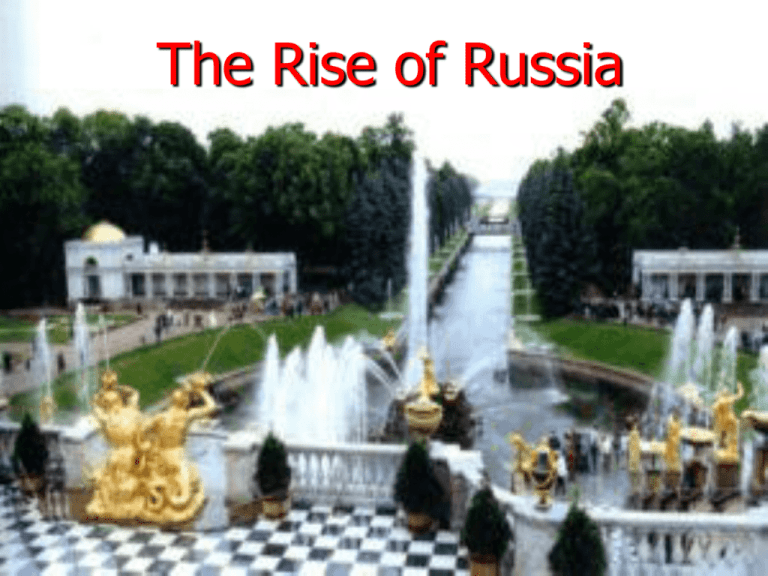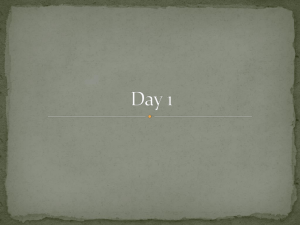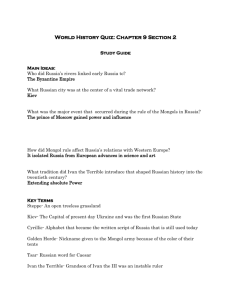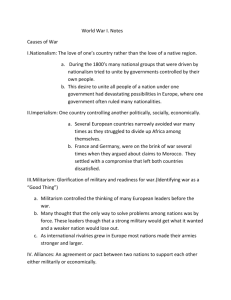The Rise of Russia
advertisement

The Rise of Russia Gunpowder Empire An empire using military power to conquer and control neighboring regions. Ivan the Great Ruled from 14621505 Successfully overthrew the Tatars (Mongols) United Russia Ivan the Terrible Ruled 1547-1584 Grandson of Ivan III 1st Tsar of Russia Began eastward expansion of Russia Used handpicked militia to rape, loot, burn, kill and torture in the Tsar's name Michael Romanov The Times of Trouble (1598-1613) Ruled from 1613 to 1645 Founder of the Romanov dynasty, which ruled Russia until 1917 Brought peace to Russia Peter the Great Ruled 1682-1725 Worked to westernize Russia Parliamentary Government Moved capitol to St. Petersburg Reforms of Peter the Great invited the best European engineers, shipbuilders, architects, craftsmen and merchants to come to Russia sent 100’s of Russians to Europe to be educated Participated in Baltic Sea trade Built a navy Established that each Tsar may choose his successor Russian Economy Agriculture, mining, & metal works Serfdom: subject to taxation, owed labor services to lords and the government, were later sold into manufacturing Traded with central Asian nomads Merchants devalued What were the similarities and differences of the development of the Russian empire from 1480 to 1800 and the expansion of the West during the same period. Russia & Europe Both expansions were based on military superiority over less technologically advanced peoples. There were economic zones along frontiers and a colonial system, incorporating ethnic diversity resulted. Russia & Europe Russian expansion was different because the Russians created a land-based empire; they lacked a mercantile fleet and had only a limited military navy. The Russians failed to achieve economic parity with Western empires, and they did not cause a demographic disaster similar to the European impact on the Americas and Polynesia. The Russians did not establish the same economic dominance over frontiers as did the West. Russia & Europe They failed to develop merchant classes and the state, unlike the West, was in charge of capitalizing ventures. Russian retention of an estate agricultural system was more typical of dependent economic zones than of Western core regions. They retained a coercive labor system, depended upon the export of raw materials, and imported manufactures and luxuries. What was the impact of Westernization in Russia during the seventeenth and eighteenth centuries? Did the process overcome the separation of Russia and the West? Westernization of Russia Westernization introduced Western art forms; Peter the Great mandated Western dress styles. Western political organization was utilized to establish an effective tsarist autocracy, although grants of local authority to the nobility under Catherine the Great reduced the ability of the central government to control the masses of the people. Although the economy remained largely agricultural, economic reforms enabled the development of industry essentially devoted to military production (mining and metallurgy). Economic development was based on the increasing exploitation of a peasant labor force. Westernization of Russia Westernization failed to overcome the separation between Russia and the West because the reforms affected only the nobility and did not make complete changes among them. The masses continued to rely on the Orthodox Church to supply primary cultural influence. Social organization remained typical of large estate agricultural systems. Unlike the Western development of a proletariat less tied to the land, Russia maintained a rigid serfdom. Russia actually was drawn into the global trading network as a dependent zone.








